
/
June 2, 2022
/
#
Min Read
Doing UBI Right
Usage Based Insurance (UBI) benefits all parties involved. Consumers receive insurance rates based on their actual driving behaviors, insurers have an accurate method for calculating user risk, and manufacturers have a new form of downstream revenue. Although there are several options for the collection of vehicle-generated data, the superior approach is leveraging embedded telematics. The only question that remains is how can OEMs realistically implement UBI and begin reaping the benefits? That’s exactly what we are going to cover in this final chapter of our UBI blog series.
Data Collection and Permission
The first step to implementing UBI is establishing a means of collecting accurate and diverse vehicle-generated data, which as we established last time, is achievable with an embedded telematics approach. The next step involves obtaining the user’s consent, which might not be as cut and dry as it seems. According to a 2021 survey by KPMG, 86% of respondents have increasing concerns about data privacy, while 30% said there are no circumstances that would induce them to share their data. Automakers must start with building a trusting relationship with their customers by taking steps to ensure their data is protected and used responsibly. Some actions OEMs can take are:
- Show customers exactly how data is used for UBI calculations
- Allow customers to review and access their vehicle data on-demand
- Use proxies instead of Vehicle Identification Numbers and other personal identifiers
- Prohibit insurers from using data for non-insurance purposes
- Utilize a cybersecurity framework for data collection and analysis
Once owner consent is provided, manufacturers can start collecting data from every electronic control unit (ECU) in the vehicle and begin building an accurate user profile.
Data Analytics
Even the simplest connected vehicles generate about 25,000 megabytes of data each hour. To put this into perspective, an hour of video streaming rounds out to around 870 MG. Before automakers can analyze all this information they will need to eliminate redundancies and irrelevant data points. This might take a bit of initial trial and error. As we discussed in our last post, many traditional UBI options are based on a limited number of data points. However, as OEMs transition from these antiquated systems to a more comprehensive data collection approach, they risk discounting potentially telling data. Let’s look at an example.
Through rudimentary UBI, Larry has been identified as a good driver. He avoids risky behaviors such as exceeding the speed limit and sudden braking. However, with an embedded telematics approach we can access novel data, such as seat belt status. After analyzing this new data we discover that Larry, and even some of his passengers, rarely wear their seatbelts. According to the National Highway Traffic Safety Administration, not wearing a seatbelt increases the risk of serious injury by 50% and risk of death by 45%. In response to this new information, Larry’s insurance company can (and likely will) increase his rates. Larry might not like it, but hopefully, the incentive of a lower premium will encourage him to buckle up more often.
So, how do automakers determine a driver’s risk potential? One of the easiest ways is to feed relevant data into a regression analysis or other model to generate a score. Auto insurers can then utilize this score to determine the appropriate premiums and discounts.
The Evolution of UBI
The more data a UBI statistical model receives, the quicker it can evolve and improve its predictions. As a result, insurers will be able to assign lower premiums for good drivers with confidence. Automakers will also benefit from increased marketability. Cars that come equipped with embedded UBI offer users long-term benefits. Meanwhile, cars without UBI promise nothing but inaccurate and potentially unfair insurance rates.
The final step to ensuring the accuracy of UBI statistical algorithms is to regularly check them for unintentional human biases and errors. For example, automatically charging higher rates for cars that frequent lower-income neighborhoods, even when the drivers show impeccable habits and have never filed an insurance claim. Eliminating these discrepancies not only provides fairer rates but also encourages more consumers to opt into UBI, which ultimately increases its accuracy.
Partnering With Sibros
Even with this step-by-step approach, the effective implementation of UBI can be challenging and stressful. This is especially true when OEMs lack the means of accessing the vehicle-generated required to run their statistical analyses. Instead of scrapping the idea altogether, manufacturers can turn to an out-of-the-box OTA update and data management solution like Sibros.
Sibros’ Deep Logger collects millisecond-level data from every vehicle ECU to provide OEMs and insurers alike with a comprehensive picture of driver behaviors and vehicle usage. It enables customizable parameters to dynamically access, sort, and amalgamate relevant data and reduces data transfer and storage costs with advanced edge filtering and data compression. Sibros’ automotive SaaS solution empowers OEMs to quickly establish, monetize, and maintain UBI programs. To learn more about how we can turn your vehicle data into dollars, contact us today.






-min.png)



